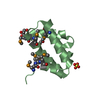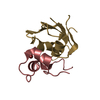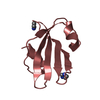[English] 日本語
 Yorodumi
Yorodumi- PDB-3ma5: Crystal structure of the tetratricopeptide repeat domain protein ... -
+ Open data
Open data
- Basic information
Basic information
| Entry | Database: PDB / ID: 3ma5 | ||||||
|---|---|---|---|---|---|---|---|
| Title | Crystal structure of the tetratricopeptide repeat domain protein Q2S6C5_SALRD from Salinibacter ruber. Northeast Structural Genomics Consortium Target SrR115c. | ||||||
 Components Components | Tetratricopeptide repeat domain protein Tetratricopeptide repeat Tetratricopeptide repeat | ||||||
 Keywords Keywords |  structural genomics / unknown function / structural genomics / unknown function /  Tetratricopeptide repeat domain protein / NESG / PSI-2 / Tetratricopeptide repeat domain protein / NESG / PSI-2 /  Protein Structure Initiative / Northeast Structural Genomics Consortium Protein Structure Initiative / Northeast Structural Genomics Consortium | ||||||
| Function / homology |  Function and homology information Function and homology information Tetratricopeptide repeat / Tetratricopeptide repeat /  Tetratricopeptide repeat domain / Tetratricopeptide repeat domain /  Tetratricopeptide repeat / TPR repeat profile. / Tetratricopeptide repeat / TPR repeat profile. /  Tetratricopeptide repeats / Tetratricopeptide repeats /  Tetratricopeptide repeat / Serine Threonine Protein Phosphatase 5, Tetratricopeptide repeat / Tetratricopeptide repeat / Serine Threonine Protein Phosphatase 5, Tetratricopeptide repeat /  Alpha Horseshoe / Tetratricopeptide-like helical domain superfamily / Mainly Alpha Alpha Horseshoe / Tetratricopeptide-like helical domain superfamily / Mainly AlphaSimilarity search - Domain/homology | ||||||
| Biological species |    Salinibacter ruber (bacteria) Salinibacter ruber (bacteria) | ||||||
| Method |  X-RAY DIFFRACTION / X-RAY DIFFRACTION /  SYNCHROTRON / SYNCHROTRON /  MOLECULAR REPLACEMENT / Resolution: 2.8 Å MOLECULAR REPLACEMENT / Resolution: 2.8 Å | ||||||
 Authors Authors | Vorobiev, S. / Neely, H. / Seetharaman, J. / Wang, H. / Foote, E.L. / Ciccosanti, C. / Mao, L. / Xiao, R. / Acton, T.B. / Montelione, G.T. ...Vorobiev, S. / Neely, H. / Seetharaman, J. / Wang, H. / Foote, E.L. / Ciccosanti, C. / Mao, L. / Xiao, R. / Acton, T.B. / Montelione, G.T. / Hunt, J.F. / Tong, L. / Northeast Structural Genomics Consortium (NESG) | ||||||
 Citation Citation |  Journal: To be Published Journal: To be PublishedTitle: Crystal structure of the tetratricopeptide repeat domain protein Q2S6C5_SALRD from Salinibacter ruber. Authors: Vorobiev, S. / Neely, H. / Seetharaman, J. / Wang, H. / Foote, E.L. / Ciccosanti, C. / Mao, L. / Xiao, R. / Acton, T.B. / Montelione, G.T. / Hunt, J.F. / Tong, L. | ||||||
| History |
|
- Structure visualization
Structure visualization
| Structure viewer | Molecule:  Molmil Molmil Jmol/JSmol Jmol/JSmol |
|---|
- Downloads & links
Downloads & links
- Download
Download
| PDBx/mmCIF format |  3ma5.cif.gz 3ma5.cif.gz | 78.1 KB | Display |  PDBx/mmCIF format PDBx/mmCIF format |
|---|---|---|---|---|
| PDB format |  pdb3ma5.ent.gz pdb3ma5.ent.gz | 59.8 KB | Display |  PDB format PDB format |
| PDBx/mmJSON format |  3ma5.json.gz 3ma5.json.gz | Tree view |  PDBx/mmJSON format PDBx/mmJSON format | |
| Others |  Other downloads Other downloads |
-Validation report
| Arichive directory |  https://data.pdbj.org/pub/pdb/validation_reports/ma/3ma5 https://data.pdbj.org/pub/pdb/validation_reports/ma/3ma5 ftp://data.pdbj.org/pub/pdb/validation_reports/ma/3ma5 ftp://data.pdbj.org/pub/pdb/validation_reports/ma/3ma5 | HTTPS FTP |
|---|
-Related structure data
| Related structure data |  2kclS S: Starting model for refinement |
|---|---|
| Similar structure data | |
| Other databases |
- Links
Links
- Assembly
Assembly
| Deposited unit | 
| ||||||||
|---|---|---|---|---|---|---|---|---|---|
| 1 | 
| ||||||||
| 2 | 
| ||||||||
| 3 | 
| ||||||||
| 4 | 
| ||||||||
| Unit cell |
| ||||||||
| Details | Dimer according to gel filtration |
- Components
Components
| #1: Protein |  Tetratricopeptide repeat Tetratricopeptide repeatMass: 11618.613 Da / Num. of mol.: 4 Source method: isolated from a genetically manipulated source Source: (gene. exp.)    Salinibacter ruber (bacteria) / Strain: HAMAP DSM 13855 / Gene: SRU_0103 / Plasmid: pET 21-23C / Production host: Salinibacter ruber (bacteria) / Strain: HAMAP DSM 13855 / Gene: SRU_0103 / Plasmid: pET 21-23C / Production host:   Escherichia coli (E. coli) / Strain (production host): BL21(DE3) +Magic / References: UniProt: Q2S6C5 Escherichia coli (E. coli) / Strain (production host): BL21(DE3) +Magic / References: UniProt: Q2S6C5#2: Water | ChemComp-HOH / |  Water Water |
|---|
-Experimental details
-Experiment
| Experiment | Method:  X-RAY DIFFRACTION / Number of used crystals: 1 X-RAY DIFFRACTION / Number of used crystals: 1 |
|---|
- Sample preparation
Sample preparation
| Crystal | Density Matthews: 2.51 Å3/Da / Density % sol: 51.09 % |
|---|---|
Crystal grow | Temperature: 291 K / Method: microbatch under paraffin oil / pH: 7 Details: 45-60% PEG 400, 0.03-0.05M potassium chloride, 0.1M Bis-Tris, pH 7.0, microbatch under Paraffin oil, temperature 291K |
-Data collection
| Diffraction source | Source:  SYNCHROTRON / Site: SYNCHROTRON / Site:  NSLS NSLS  / Beamline: X4C / Wavelength: 0.97869 Å / Beamline: X4C / Wavelength: 0.97869 Å |
|---|---|
| Detector | Type: MAR CCD 165 mm / Detector: CCD / Date: Mar 15, 2010 |
| Radiation | Protocol: SINGLE WAVELENGTH / Monochromatic (M) / Laue (L): M / Scattering type: x-ray |
| Radiation wavelength | Wavelength : 0.97869 Å / Relative weight: 1 : 0.97869 Å / Relative weight: 1 |
| Reflection | Resolution: 2.8→50 Å / Num. all: 22394 / Num. obs: 22372 / % possible obs: 99.9 % / Observed criterion σ(F): 0 / Observed criterion σ(I): 0 / Redundancy: 21.5 % / Rmerge(I) obs: 0.076 / Net I/σ(I): 59.1 |
| Reflection shell | Resolution: 2.8→2.9 Å / Redundancy: 22 % / Rmerge(I) obs: 0.941 / Mean I/σ(I) obs: 3.47 / Num. unique all: 2244 / % possible all: 100 |
- Processing
Processing
| Software |
| |||||||||||||||||||||||||||||||||||||||||||||||||||||||||||||||
|---|---|---|---|---|---|---|---|---|---|---|---|---|---|---|---|---|---|---|---|---|---|---|---|---|---|---|---|---|---|---|---|---|---|---|---|---|---|---|---|---|---|---|---|---|---|---|---|---|---|---|---|---|---|---|---|---|---|---|---|---|---|---|---|---|
| Refinement | Method to determine structure : :  MOLECULAR REPLACEMENT MOLECULAR REPLACEMENTStarting model: PDB ENTRY 2KCL Resolution: 2.8→44.885 Å / SU ML: 0.42 / Cross valid method: THROUGHOUT / σ(F): 1.25 / Stereochemistry target values: ML Details: There are four molecules (two dimers) in AU. The fourth molecule (D) has very bad defined electron density and was not found by MR. Based on the partial electron density and dimer structure ...Details: There are four molecules (two dimers) in AU. The fourth molecule (D) has very bad defined electron density and was not found by MR. Based on the partial electron density and dimer structure C-terminal part (78-145) of molecule D was built; however B-factor for D molecule is higher than for A-C molecules.
| |||||||||||||||||||||||||||||||||||||||||||||||||||||||||||||||
| Solvent computation | Shrinkage radii: 0.9 Å / VDW probe radii: 1.11 Å / Solvent model: FLAT BULK SOLVENT MODEL / Bsol: 72.224 Å2 / ksol: 0.333 e/Å3 | |||||||||||||||||||||||||||||||||||||||||||||||||||||||||||||||
| Refinement step | Cycle: LAST / Resolution: 2.8→44.885 Å
| |||||||||||||||||||||||||||||||||||||||||||||||||||||||||||||||
| Refine LS restraints |
| |||||||||||||||||||||||||||||||||||||||||||||||||||||||||||||||
| LS refinement shell |
|
 Movie
Movie Controller
Controller













 PDBj
PDBj



